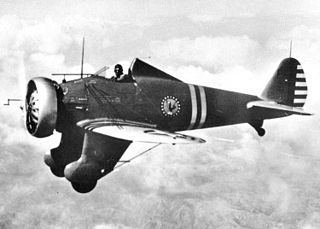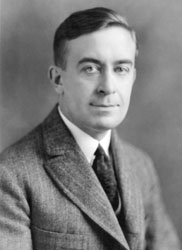Related Research Articles

The Lockheed Corporation was an American aerospace manufacturer. Lockheed was founded in 1926 and later merged with Martin Marietta to form Lockheed Martin in 1995. Its founder, Allan Lockheed, had earlier founded the similarly named but otherwise-unrelated Loughead Aircraft Manufacturing Company, which was operational from 1912 to 1920.

Edward Vernon Rickenbacker was an American fighter ace in World War I, and a Medal of Honor recipient. With 26 aerial victories, he was the United States' most successful fighter ace in the war and is considered to have received the most awards for valor by an American during the war. He was also a race car driver and automotive designer, a government consultant in military matters and a pioneer in air transportation, particularly as the long-time head of Eastern Air Lines.

The National Advisory Committee for Aeronautics (NACA) was a United States federal agency founded on March 3, 1915, to undertake, promote, and institutionalize aeronautical research. On October 1, 1958, the agency was dissolved and its assets and personnel were transferred to the newly created National Aeronautics and Space Administration (NASA). NACA is an initialism, i.e., pronounced as individual letters, rather than as a whole word.

The Boeing P-26 "Peashooter" was the first American production all-metal fighter aircraft and the first pursuit monoplane to enter squadron service with the United States Army Air Corps. Designed and built by Boeing, the prototype first flew in 1932, and the type was still in use with the U.S. Army Air Corps as late as 1941 in the Philippines. There are two surviving Peashooters, but there are three reproductions on display with two more under construction.

The Soviet Air Forces were one of the air forces of the Soviet Union. The other was the Soviet Air Defence Forces. The Air Forces were formed from components of the Imperial Russian Air Service in 1917, and faced their greatest test during World War II. The groups were also involved in the Korean War, and dissolved along with the Soviet Union itself in 1991–92. Former Soviet Air Forces' assets were subsequently divided into several air forces of former Soviet republics, including the new Russian Air Force. "March of the Pilots" was its song.

Glenn Hammond Curtiss was an American aviation and motorcycling pioneer, and a founder of the U.S. aircraft industry. He began his career as a bicycle racer and builder before moving on to motorcycles. As early as 1904, he began to manufacture engines for airships. In 1908, Curtiss joined the Aerial Experiment Association, a pioneering research group, founded by Alexander Graham Bell at Beinn Bhreagh, Nova Scotia, to build flying machines.

The ERCO Ercoupe is an American low-wing monoplane aircraft that was first flown in 1937. It was originally manufactured by the Engineering and Research Corporation (ERCO) shortly before World War II; several other manufacturers continued its production after the war. The final model, the Mooney M-10, first flew in 1968 and the last model year was 1970. It was designed to be the safest fixed-wing aircraft that aerospace engineering could provide at the time, and the type continues to enjoy a faithful following.

Francisco Anthony "Frank" Lorenzo is an American businessman. He is well known for his management of Continental Airlines and Texas International Airlines, between 1972 and 1990, through airline deregulation. Lorenzo also led the creation and management of the holding company for the group, Texas Air Corporation, through which New York Air was formed in 1980 and Eastern Air Lines was acquired in 1986, as well as Frontier Airlines and People Express Airlines.

Miles was the name used between 1943 and 1947 to market the aircraft of British engineer Frederick George Miles, who, with his wife – aviator and draughtswoman Maxine "Blossom" Miles – and his brother George Herbert Miles, designed numerous light civil and military aircraft and a range of curious prototypes.
This is a list of aviation-related events from 1929:

The de Havilland DH.89 Dragon Rapide is a 1930s short-haul biplane airliner developed and produced by British aircraft company de Havilland. Capable of accommodating 6–8 passengers, it proved an economical and durable craft, despite its relatively primitive plywood construction.

Military gliders have been used by the militaries of various countries for carrying troops and heavy equipment to a combat zone, mainly during the Second World War. These engineless aircraft were towed into the air and most of the way to their target by military transport planes, e.g., C-47 Skytrain or Dakota, or bombers relegated to secondary activities, e.g., Short Stirling. Most military gliders do not soar, although there were attempts to build military sailplanes as well, such as the DFS 228.
Allen Eugene Paulson was an American businessman.

Sometimes dubbed the Golden Age of Aviation, the period in the history of aviation between the end of World War I (1918) and the beginning of World War II (1939) was characterised by a progressive change from the slow wood-and-fabric biplanes of World War I to fast, streamlined metal monoplanes, creating a revolution in both commercial and military aviation. By the outbreak of World War II in 1939 the biplane was all but obsolete. This revolution was made possible by the continuing development of lightweight aero engines of increasing power. The jet engine also began development during the 1930s but would not see operational use until later.

Alfred Victor Verville was an American aviation pioneer and aircraft designer who contributed to civilian and military aviation. During his forty-seven years in the aviation industry, he was responsible for the design and development of nearly twenty commercial and military airplanes. Verville is known for designing flying boats, military racing airplanes, and a series of commercial cabin airplanes. His planes were awarded with the Pulitzer Speed Classic Trophy in 1920 and 1924.

Aircraft manufacturing is an important industrial sector in Russia, employing around 355,300 people. The dissolution of the Soviet Union led to a deep crisis for the industry, especially for the civilian aircraft segment. The situation started improving during the middle of the first decade of the 2000s due to growth in air transportation and increasing demand. A consolidation programme launched in 2005 led to the creation of the United Aircraft Corporation holding company, which includes most of the industry's key companies.

The Douglas DC-2 is a 14-passenger, twin-engined airliner that was produced by the American company Douglas Aircraft Company starting in 1934. It competed with the Boeing 247. In 1935, Douglas produced a larger version called the DC-3, which became one of the most successful aircraft in history.

Vance Breese (1904–1973) was an American aviation engineer and test pilot.

The Rider R-6 was the last of the Keith Rider designed racing aircraft of the 1930s.
The history of Wichita details the history of Wichita, Kansas from its initial settlement in the 1860s to the present day.
References
- ↑ "EIGHT PLANES SET FOR THOMPSON RACE". New York Times. 2 September 1938.
- ↑ John Underwood. Grand Central Air Terminal. p. 74.
- ↑ Mike Kusenda (Spring 1981). "The Keith Rider R-6 - Behind the Eightball". Journal of the American Aviation Historical Society.
- ↑ American Aviation Vol 5: 49. 1941.
{{cite journal}}: Missing or empty|title=(help) - ↑ Writers' Program of the Work Projects Administration in the State of Illinois. Who's who in aviation. p. 357.